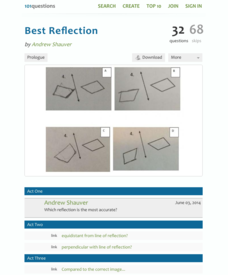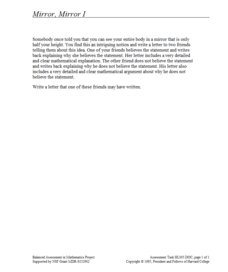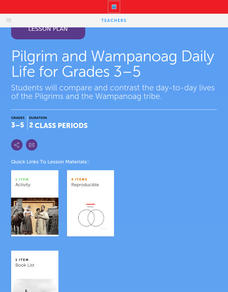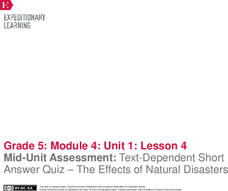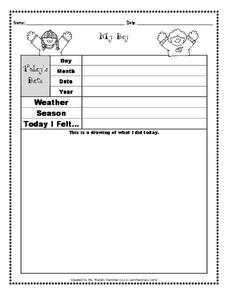GeoGebra
Leaping Lizards
Transform lizards onto different locations. The interactive provides a diagram of a lizard and several locations. Pupils use their knowledge of transformations to move the lizard to the different locations and use the tools of GeoGebra...
101 Questions
Best Reflection
Which is the best reflection of them all? Given four diagrams, pupils determine which one shows the most accurate reflection of a quadrilateral. Two images provide the distances of each vertex from the line of reflection, as well as the...
Concord Consortium
Mirror, Mirror I
How do you see yourself? Young mathematicians consider whether it's possible to view their whole bodies in a mirror with a length that is half their height. They write a letter to a friend explaining their positions mathematically.
CCSS Math Activities
Smarter Balanced Sample Items: 8th Grade Math – Target G
Transform the thinking of transformations with six sample items that illustrate the first four standards in the eighth grade geometry domain. Items use the coordinate plane to transform figures and analyze the relationship of the figures...
Good Project by Harvard Project Zero
The Good Project Lesson Plans
Excellence, ethics, and engagement are the three E's featured in a unit that promotes good work among elementary scholars. Through discussion, reflection, read-alouds, activity worksheets, and written responses, participants gain...
International Technology Education Association
Singin' the Black and Blues
How does the color of the sky change from blue to reds and oranges to black? An illuminating lesson explains how light travels through different mediums using the sun's light as an example. By examining diagrams and illustrations, pupils...
American Museum of Natural History
See the Light
It's time to see the light! Scholars perform three different experiments with light to reveal properties using a great remote learning resource. The pupils see how light reflects from a surface and refracts through different materials....
Equality and Human Rights Commission
Learning area 5: Job Done!
Four activities conclude a unit through discussion and activities inspired by reflection. Scholars revisit their storybook from the first unit. Self-portraits showcase thought bubbles with written statements. Groups write and perform a...
Missouri Department of Elementary
Other Changes (Life-Changing Events Outside of the Family)
Change is inevitable. Kindergarteners discuss coping skills to properly manage changes that can occur outside the family. Scholars reflect on their life changes after starting kindergarten. They discuss their feelings and draw a...
EngageNY
Final Performance Task: Sharing Visual Representations of Position Papers
Take note! Scholars use sticky notes to record information as they gallery walk to look at classmates' visual representations they created for their end of unit assessment. Learners then choose one word that represents the work they...
Scholastic
Pilgrim and Wampanoag Daily Life for Grades 3-5
Thirteen steps make up a lesson plan that challenges pupils to compare and contrast the daily lives of Pilgrims and the Wampanoag tribe. Learners revisit the Graffiti Wall then break into small groups for an investigative reading...
Scholastic
The First Thanksgiving Feast for Grades 3-5
Scholars examine the first Thanksgiving through books and interviews while they complete a KWL chart. Pretending they are part of the feast, learners craft a scrapbook page that features images related to their experience. Pupils reflect...
EngageNY
Completing Reflection: Preparing a Poster for Presentation
Prewrite, plan, draft, revise, edit, share. Scholars complete a worksheet to reflect on how they used the writing process to improve their writing. They also draft plans for their scientific posters that they will display in an upcoming...
EngageNY
Mid-Unit Assessment: Text-Dependent Short-Answer Quiz—The Effects of Natural Disasters
Readers complete a mid-unit assessment by reading the text How Do Hurricanes Form? They answer text-dependent questions about hurricanes with short answer and sequencing. Learners then participate in a read aloud and text chunking...
Flipped Math
Transformations
Transformations come in many forms. To start the informative resource, pupils first review the different types of transformations. Scholars work in more detail with translations by drawing the transformations and writing the algebraic...
Dawgeared.com
Book Review
Reflect on your reading with a book review form. After finishing a novel or short story, kids choose the correct genre and discuss their favorite part. They also decide which part they would change, and whether or not they would...
K12 Reader
The Art of M.C. Escher
Show your class one way in which art and math are related by teaching them about M.C. Escher. Class members read a brief passage and then respond to five related questions.
Math Sphere
Co-Ordinates
Challenge young mathematicians' understanding of the coordinate plane with this series of skills practice worksheets. Offering 10 different exercises that involve identifying ordered pairs,...
Curated OER
My Day
Youngsters summarize how they felt and what they did on any given day with this adorable template! The document includes space for learners to write the date, weather and season, drawing of the day's major events, and summary of what...
Vancouver Community College Learning Centre
Symmetry & Odd/Even Functions
This straightforward worksheet provides learners with valuable practice in identifying different symmetries of functions. Brief, but thorough explication at the front of the worksheet guides and reminds learners of the techniques...
Murrieta Valley Unified School District
AVID End of the Year Reflection
Encourage your class members to take the time to reflect on significant events and people from the school year. While originally designed for an AVID class, the writing prompts in this worksheet will inspire self-reflection for...
Curriculum Corner
8th Grade Math Common Core Checklist
Ensure your eighth graders get the most out of their math education with this series of Common Core checklists. Rewriting each standard as an "I can" statement, this resource helps teachers keep a record of when each standard was...
Illustrative Mathematics
Why Does SSS Work?
While it may seem incredibly obvious to the geometry student that congruent sides make congruent triangles, the proving of this by definition actually takes a bit of work. This exercise steps the class through this kind of proof by...
Have Fun Teaching
Scientific Method
Encourage your students' inner scientist by conducting experiments and recording their findings. This printable incorporates every part of the scientific method into an easy-to-read outline of experimental questions, research,...
Other popular searches
- Alphabet Mirror Image
- Translations and Reflections
- Plane Mirror Image
- Geometry Reflections
- Mirror Image Illustrations
- Reflections Rotations
- Rotations and Reflections
- Line Reflections
- Glide Reflections
- Mirrors Reflections Math
- Mirrors Reflections
- Geometric Reflections

